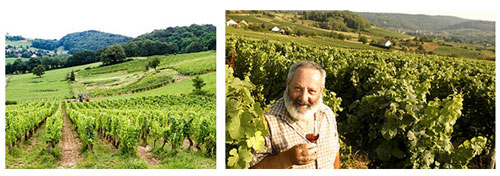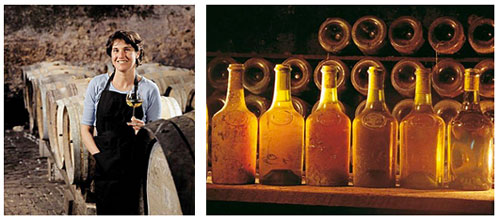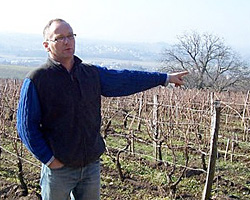| « Previous | News | Next » |
February 10, 2015
Jura: The Next Small Thing
As the smallest appellation in France with an entirely idiosyncratic way of making wine, Jura has serious indie cred. Thanks to isolation afforded by the wooded, rolling Jura Mountains, this region between Burgundy and Switzerland has developed a unique style that you won’t find replicated anywhere. The wines are quirky, food-friendly—and really, really good. Some Jura winemakers have taken steps toward making more readily recognizable table wines, but truly, its deeply rooted traditional style is what has put it on the map: oxidated, nutty whites; meaty, light-bodied reds with grip; and an array of dessert wines—all from mostly native grapes.

Lately, Jura wine has an increasing buzz about it: it’s popping up on Chicago wine lists from Sepia to Longman & Eagle. And, with the recent retirement of Jacques Puffeney, the well-loved “pope of Jura,” journalists have been shining a spotlight on this tiny nook of northeastern France, curious to know what will become of the estate now in the hands of a Burgundian, Guillaume d’Angerville.
But the Jura is hardly a flash in the pan, despite how many times people claim that it is “up and coming.” In fact, the Jurassic Era was named after this region, where geologic limestone formations of the age were first studied—the same limestone and marl that help Juran vines thrive. Winemaking in Jura dates back to at least the first century AD, when Pliny the Younger was praising Jura’s wines in Rome. The region’s wine production hit its peak at the end of the 19th century, with 20,000 hectares under vine. Thanks to phylloxera and two world wars, today’s production is more like 2,000 hectares, with only 200 producers and very few interested in exporting their wines. This rareness in the market definitely adds to its intrigue.
 Vin Jaune (“yellow wine”) is undoubtedly the international star of Jura wine, with a reputation for captivatingly nutty, sherrylike aromas. Domaine de Montbourgeau in L’Etoille region has been making it, along with other stalwart wines of the region, since 1920, and produces a version that has ample weight, but is light on its feet. Now run by Nicole Deriaux, the granddaughter of the original vigneron, the wines are organic, hand harvested, and meticulously crafted. Her Vin Jaune is made from late-harvest Savagnin—the Juran cousin of Gewurztraminer. In traditional fashion, the wine is aged in large barrels under a thin veil of yeast; the process has similarities to Sherry, but the wine is not fortified. The wine develops in barrel for at least seven years, and is never topped off. The 2007 Vin Jaune is a gorgeous golden poppy color. It exudes notes of walnuts, saffron, sap, and hints of lemon. On the palate, there’s a marzipan and roasted-chestnut richness, which carries through to the long, ambling finish. It has a decided place at the table: try it with a rustic artichoke tart.
Vin Jaune (“yellow wine”) is undoubtedly the international star of Jura wine, with a reputation for captivatingly nutty, sherrylike aromas. Domaine de Montbourgeau in L’Etoille region has been making it, along with other stalwart wines of the region, since 1920, and produces a version that has ample weight, but is light on its feet. Now run by Nicole Deriaux, the granddaughter of the original vigneron, the wines are organic, hand harvested, and meticulously crafted. Her Vin Jaune is made from late-harvest Savagnin—the Juran cousin of Gewurztraminer. In traditional fashion, the wine is aged in large barrels under a thin veil of yeast; the process has similarities to Sherry, but the wine is not fortified. The wine develops in barrel for at least seven years, and is never topped off. The 2007 Vin Jaune is a gorgeous golden poppy color. It exudes notes of walnuts, saffron, sap, and hints of lemon. On the palate, there’s a marzipan and roasted-chestnut richness, which carries through to the long, ambling finish. It has a decided place at the table: try it with a rustic artichoke tart.
Domaine de Montbourgeau also makes a nonvintage Macvin, a traditional-style dessert wine made from Chardonnay and Poulsard (a native red grape), fortified with the local brandy called “Marc.” This is also aged in oak casks for several years to develop depth and complexity. Its nose is a bucolic array of honey, flowers, pine, and orange blossom. Pair with Comte cheese, another glorious specialty of the region. Better yet, take it on your next picnic: it’s remarkably comfortable alongside smoked ham and various charcuterie.
For an excellent version of Cremant du Jura, turn to Champ Divin, a biodynamic estate in Gevingy. Valerie and Fabrice Closset-Gaziaux started as organic agricultural advisers in Africa and France before beginning their own project at the foot of Jura’s “first plateau” on silty-clay and limestone soils. The grapes are hand harvested, fermented with natural yeasts, and receive minimal sulfur. Their Cremant is lively and fresh, with delicate peach and brioche notes. It’s a bang-up pair with bacon-wrapped dates. Their “Cuvee Pollux” consists of Chardonnay and Sauvignin, vinified in a tightrope style between the creamy, oxidative Juran sensibility and breezy refreshingness. It’s the best of both worlds, and absolutely perfect for the table. The notes of curry and dried fruit pair well with the sweet-savory yin yang of carrot soup.
 For a fantastic example of the Arbois AOC style, try Michel Gahier 2012 Chardonnay “Les Follasses” Arbois Blanc AOC. The Gahier family has been in the Jura since 1525, in the village of Montigny-les-Arsures, a district that produces some of the finest wines of the Arbois appellation. Gahier is a neighbor and friend of Jacques Puffeney, and shares Puffeney’s desire to express the very particular terroir of this corner of the Jura by harvesting and vinifying his wines parcel by parcel. Each wine ultimately is derived exclusively from a single vineyard site. “Les Follasses” is produced sous-voile, and spends considerable time aging in barrel, achieving creamy hazelnut notes. The viticulture is organic and the wines are bottled without filtration.
For a fantastic example of the Arbois AOC style, try Michel Gahier 2012 Chardonnay “Les Follasses” Arbois Blanc AOC. The Gahier family has been in the Jura since 1525, in the village of Montigny-les-Arsures, a district that produces some of the finest wines of the Arbois appellation. Gahier is a neighbor and friend of Jacques Puffeney, and shares Puffeney’s desire to express the very particular terroir of this corner of the Jura by harvesting and vinifying his wines parcel by parcel. Each wine ultimately is derived exclusively from a single vineyard site. “Les Follasses” is produced sous-voile, and spends considerable time aging in barrel, achieving creamy hazelnut notes. The viticulture is organic and the wines are bottled without filtration.
There’s an artisanal spirit in the rural Jura region. It’s a place where winemaking is craftsmanlike, natural, and deeply tied to tradition. There are no industrial cities, but you’ll find many small villages defined by the mountains. You’ll find intricate, secret forests, rushing streams, and sloping vineyards. And you’ll find amazing wine: eccentric and self-reflective, it couldn’t be from anywhere else.
